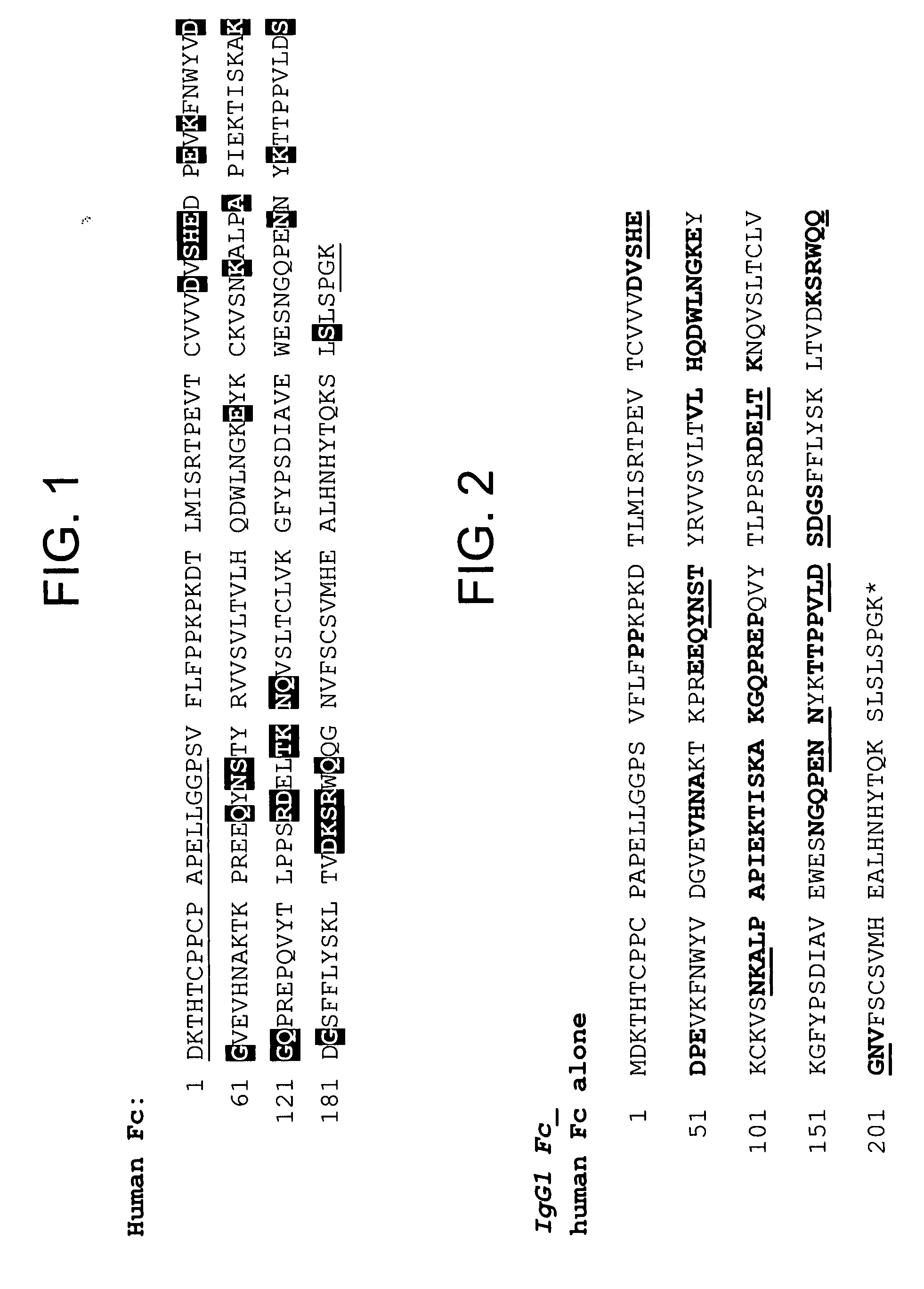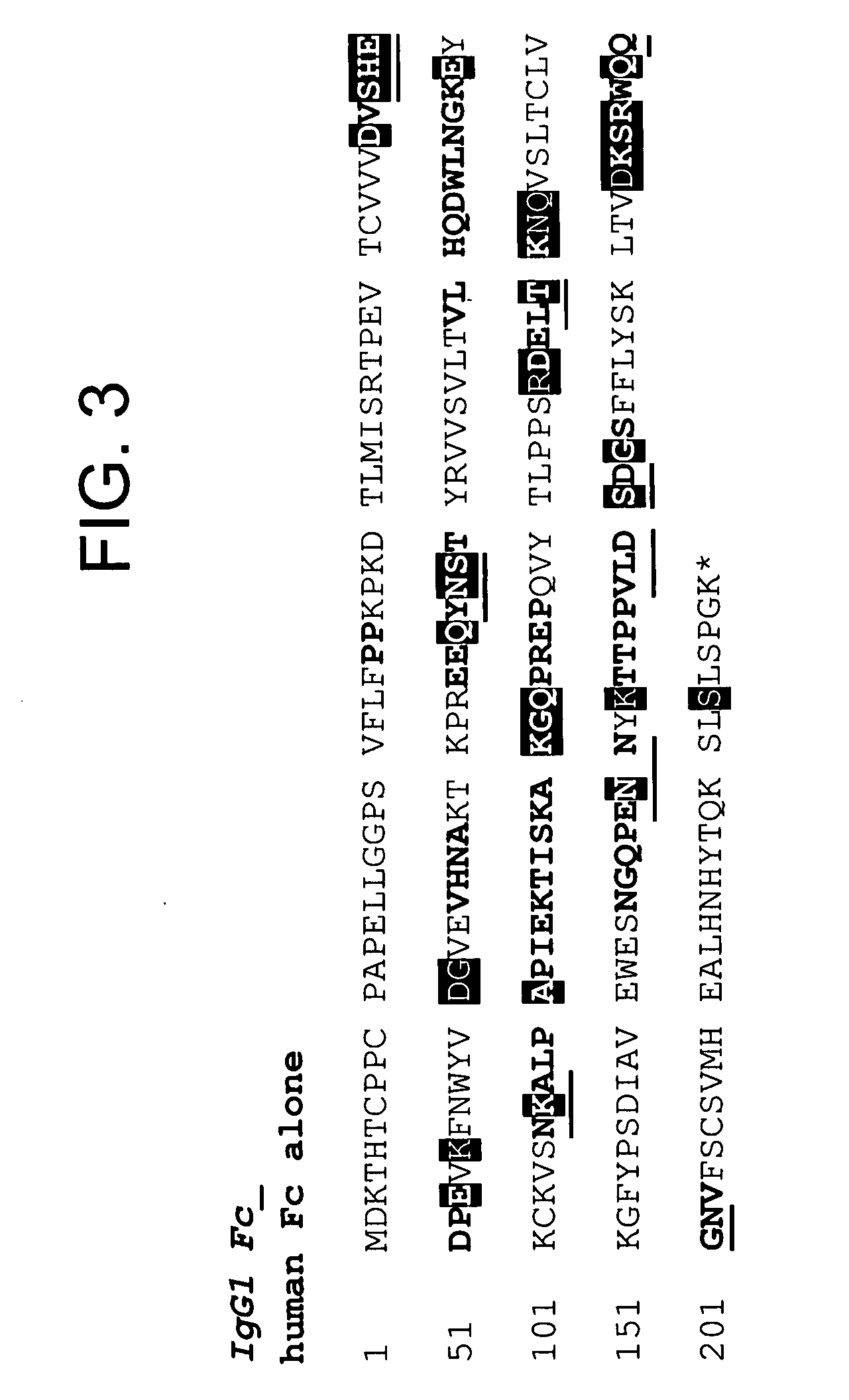Modified Fc molecules
a technology of immunoglobulin and fc domain, which is applied in the field of biochemical arts, can solve the problems of high yield, large loss of functional activity, and degree of conjugate heterogeneity
- Summary
- Abstract
- Description
- Claims
- Application Information
AI Technical Summary
Benefits of technology
Problems solved by technology
Method used
Image
Examples
example 1
huFc(IgG1) Variants Constructed for Bacterial Expression
[0501] By way of example, four variants of human Fc domain (huFc(IgG1) were constructed.
[0502] 1) huFc(IgG1) with a Q143C mutation (at position 143 of SEQ ID NO:599; designated “Strain 13300”) was made as follows. Two PCR fragments introducing the Q143C mutation were amplified from a plasmid encoding the huFc(IgG1). The first PCR fragment was amplified by the following two primers: [0503] 3430-37
[0504] GAGGAATAACATATGGACAAAACTCACACATGTCCACCT (SEQ ID NO: 641), which encodes the first 8 amino acids of huFc(IgG1) plus a 15-nucleotide 5′ extension including a NdeI site; and [0505] 4220-28 [0506] GGTCAGGCTGACGCAGTTCTTGGTCAG (SEQ ID NO: 642), which encodes 9 amino acids of huFc(IgG1) from the 139th to the 147th amino acid with the 143th amino acid mutated from Glutamine to Cysteine in the 3′ orientation.
[0507] The second PCR fragment was amplified by the following two primers: [0508] 4220-27 [0509] CTGACCAAGAACTGCGTCAGCCTGACC (SE...
example 2
Purification of Fc-Cysteine Analogs
[0556] The cDNA clones constructed as described in Example 1 hereinabove: Strain 13300 (huFc(IgG1)Q143C), Strain 13322 (huFc(IgG1)L139C), Strain 13323 (huFc(IgG1)S145C) and Strain 13324 (huFc(IgG1)S196C) were transformed in E. coli and expressed in inclusion bodies. Cell pastes from each strain were resuspended in 10 ml water / g paste, lysed by three passages through a microfluidizer and the insoluble inclusion body (IB) fraction was collected by centrifugation. The IBs were subsequently washed with 1% deoxycholate, centrifuged and washed again with water. The final pellet of deoxycholate washed inclusion bodies (DWIBs) was weighed and frozen at −80° C.
[0557] The frozen DWIBs, from each clone, were then thawed and resuspended in 1 ml water / g DWIBs, then solubilized and reduced by the addition of 9 ml of 8 M buffered Gdn-HCl, 11 mM DTT. The solubilization proceeded at room temperature, with stirring, for 1 hour.
[0558] Each huFc-cysteine analog was...
example 3
Conjugation of Polyethylene Glycol (PEG) to Fc-Cysteine Analogs
[0562] The huFc (S196C) analog, clone #13324, was selected as representative of the huFc-cysteine analogs produced, as described in Example 2 herein above, for the purpose of developing a site-selective conjugation process for the Fc-cysteine analogs. Since the LC-MS analyses of the purified huFc-cysteine analogs indicated the presence of mixed disulphides with low molecular weight adducts, a limited reduction step was undertaken prior to conjugation. This was followed by thiol specific PEGylation to assess the degree and site-selectivity of conjugation at the engineered cysteine.
[0563] Briefly, the huFc (S196C) analog described in Example 2 was partially reduced by titrating ris(2-carboxyethylphosphine) hydrochloride (TCEP) from 0-5 molar excess stoichiometries relative to the concentration of engineered cysteine. The reduction reaction was incubated 2 hours, at room temperature, in 50 mM sodium phosphate, 5 mM EDTA, ...
PUM
| Property | Measurement | Unit |
|---|---|---|
| Fraction | aaaaa | aaaaa |
| Fraction | aaaaa | aaaaa |
| Angle | aaaaa | aaaaa |
Abstract
Description
Claims
Application Information
 Login to View More
Login to View More - R&D
- Intellectual Property
- Life Sciences
- Materials
- Tech Scout
- Unparalleled Data Quality
- Higher Quality Content
- 60% Fewer Hallucinations
Browse by: Latest US Patents, China's latest patents, Technical Efficacy Thesaurus, Application Domain, Technology Topic, Popular Technical Reports.
© 2025 PatSnap. All rights reserved.Legal|Privacy policy|Modern Slavery Act Transparency Statement|Sitemap|About US| Contact US: help@patsnap.com



